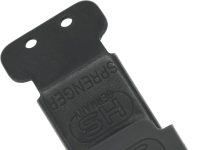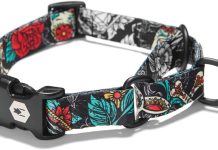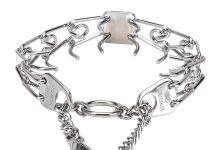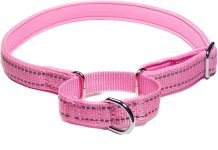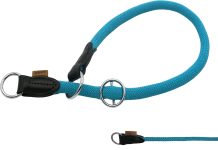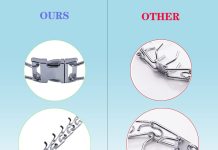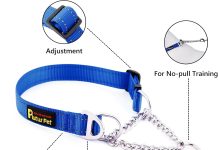This article will explore the contrasting features of shock and vibration collars commonly used in dog training.
While these two collars may appear similar, they have distinct mechanisms and purposes. Understanding the differences between them can help pet owners make an informed decision about which collar is most suitable for their furry friends.
So, let’s uncover the disparities between shock and vibration collars and ultimately find out which promotes a positive training experience for dogs.
Definition of a Shock Collar
A shock collar, also known as an electronic collar or e-collar, is a device designed to assist in dog training by providing a form of aversive stimulus. It typically consists of a receiver collar worn by the dog and a handheld remote control operated by the trainer. When triggered by the remote control, the collar delivers an electric shock to the dog.
Table of Contents
Purpose of a Shock Collar
The primary purpose of a shock collar is to modify a dog’s behavior through negative reinforcement. A static electric shock aims to deter undesirable behaviors such as excessive barking, running away, or aggressive tendencies. Shock collars are often used in training scenarios where immediate correction or control is necessary.
How a Shock Collar Works
When the trainer activates the remote control, a signal is sent to the receiver collar worn by the dog. The receiver collar then delivers a mild electric shock to the dog, typically through metal prongs that touch the skin. The intensity of the shock can usually be adjusted on the remote control, allowing for varying levels of stimulation. This interrupts the dog’s current behavior and associates it with the negative sensation, thereby discouraging the behavior over time.
Pros of Using a Shock Collar
Effective in correcting unwanted behavior
One of the advantages of using a shock collar is its effectiveness in quickly curbing undesirable behaviors. The immediate feedback from the static shock helps the dog associate the undesirable behavior with the unpleasant sensation, leading to behavior modification in a shorter time frame than other training methods.
It can be used for long-distance control
Shock collars are beneficial for training situations where the trainer needs to control the dog’s behavior from a distance. With a remote control, the trainer can deliver the stimulation from afar, allowing for consistent training and correction even when the dog is not within immediate reach.
Allows for customization of stimulation levels
Shock collars often come with adjustable stimulation levels, enabling trainers to tailor the intensity of the electric shock to suit the individual dog’s temperament and the severity of the behavior. This customization ensures that the collar’s stimulation is appropriate and effective, minimizing the risk of overcorrection.
Cons of Using a Shock Collar
It may cause pain or distress to the dog
Perhaps the most concerning drawback of shock collars is their potential to cause pain or distress to the dog. While the shocks are typically low-level, they can still be uncomfortable or even painful for the dog, significantly if misused or the shock collar is not fitted correctly. This raises ethical concerns and emphasizes the need for responsible and humane use of such devices.
This can lead to fear or aggression in some cases
In rare instances, using shock collars may elicit fear or aggression in dogs. The negative associations formed between the shock and certain situations or stimuli can make the dog anxious or defensive, potentially exacerbating behavioral problems rather than resolving them. It is crucial to carefully monitor the dog’s emotional state during and after using a shock collar to avoid any adverse effects.
It may not be suitable for sensitive or fearful dogs
Shock collars may not be appropriate for dogs with sensitive temperaments or fear-based behavioral issues. These dogs may react negatively to the aversive stimulation, amplifying their anxiety or fear responses. In such cases, alternative training methods focusing on positive reinforcement and building trust are generally recommended.
Definition of a Vibration Collar
A vibration collar, also known as a vibrating collar or pager collar, is a dog training device that utilizes vibrations to stimulate. Similar to a shock collar, it consists of a receiver collar worn by the dog and a remote control held by the trainer. Instead of delivering an electric shock, a vibration collar emits vibratory sensations to communicate with the dog.
Purpose of a Vibration Collar
The primary purpose of a vibration collar is to aid in training and communication between the trainer and the dog. It serves as a gentle reminder or cue to redirect the dog’s attention and reinforce desired behaviors. Vibration collars are often used as an alternative to shock collars, particularly for sensitive or fearful dogs.
How a Vibration Collar Works
When the trainer activates the remote control, a signal is sent to the receiver collar, emitting a vibratory sensation. The dog can feel this vibration, creating a physical sensation without causing pain. The intention is to capture the dog’s attention, provide an immediate cue or redirection, and reinforce positive behaviors.
Pros of Using a Vibration Collar
Offers a more humane alternative to shock collars
One of the key benefits of using a vibration collar is its more humane approach to dog training. Instead of relying on aversive stimuli like electric shocks, the collar utilizes vibrations for communication and gentle correction. This makes it suitable for dog owners who prioritize positive reinforcement and avoid the potential discomfort associated with shock collars.
Gentle reminder without causing pain
Vibration collars provide a gentle way to remind or redirect a dog’s behavior without causing physical pain. The vibratory sensation is a subtle cue that can catch the dog’s attention and nudge them toward the desired action. This makes vibration collars ideal for dogs that may be sensitive to more aversive forms of stimulation.
Suitable for training sensitive or fearful dogs
Vibration collars are particularly well-suited for training sensitive or fearful dogs. The non-threatening nature of the vibrations can help build trust and confidence, allowing these dogs to engage in training without the intimidation or anxiety that may arise from using shock collars. It can be a valuable tool in gradually desensitizing the dog to certain stimuli or situations.
Cons of Using a Vibration Collar
It may not be as effective for all dogs
While vibration collars can be effective for many dogs, they may not yield the same results or behavior modification as shock collars for specific individuals. Some dogs may require a more potent stimulus or find the vibrations less motivating than an electric shock’s intensity. It is essential to consider the specific needs and responsiveness of the dog when choosing a training collar.
Limited range of control compared to shock collars
Vibration collars typically have a more limited control range than shock collars. This means that the trainer must be relatively close to the dog for the collar to effectively deliver the vibratory stimulation. This factor may restrict the use of vibration collars in situations where remote control over the dog’s behavior from a distance is necessary.
Different Types of Stimulation
Static stimulation in shock collars
Shock collars utilize static stimulation, which involves the delivery of a mild electric shock to the dog. The static stimulation level can usually be adjusted on the remote control, allowing trainers to tailor the intensity of the shock to match the dog’s behavior and temperament.
Vibration as the primary stimulation in vibration collars
Vibration collars rely on vibrations as the primary form of stimulation. The vibrations emitted by the collar are typically gentle and subtle, providing a distinctive sensation to the dog without causing pain or discomfort. This unique stimulation captures the dog’s attention and encourages appropriate behaviors.
Training Methods and Objectives
Shock collars for conditioning and punishment-based training
Shock collars are often associated with conditioning and punishment-based training methods. By applying a harmful stimulus, such as an electric shock, trainers aim to deter unwanted behaviors by associating discomfort or pain. However, it is essential to note that shock collars should be used responsibly and with a proper understanding of the dog’s emotional well-being.
Vibration collars for positive reinforcement and distraction training
Vibration collars align more closely with positive reinforcement and distraction-based training methods. The vibrations act as a cue or reminder to redirect the dog’s attention or reward desired behaviors. By utilizing positive associations, trainers can encourage the dog to engage in more favorable behaviors while building a trusting and cooperative relationship.
Safety Considerations
Potential risks and side effects of shock collars
While shock collars can be practical training tools when used properly, there are potential risks and side effects to consider. Improper use or excessive levels of stimulation can cause physical and emotional distress to the dog. It is vital to carefully read and follow the manufacturer’s instructions and consult a professional trainer or behaviorist to ensure the safe and responsible use of shock collars.
Minimal risks associated with vibration collars
Vibration collars generally carry minimal risks and side effects compared to shock collars. The gentle nature of the vibrations significantly reduces the likelihood of causing physical harm or adverse reactions in the dog. However, as with any training tool, monitoring the dog’s response and adjusting the training approach accordingly is important.
Choosing the Right Collar for Your Dog
Assessing your dog’s temperament and needs
When selecting a training collar for your dog, it is crucial to consider their temperament, behavior, and specific training needs. Some dogs may respond well to the gentle reminders provided by vibration collars, while others may require the more immediate feedback of a shock collar. Understanding your dog’s unique characteristics will help determine which type of collar is most suitable.
Consulting with a professional trainer or behaviorist
To ensure the best training approach and collar selection for your dog, it is advisable to seek guidance from a professional trainer or behaviorist. These experts can assess your dog’s behavior and recommend appropriate training methods and tools based on their expertise and understanding of canine behavior. Their guidance and support will contribute to a safe and effective training experience for you and your dog.
In conclusion, shock and vibration collars serve as tools in dog training, aiming to modify behavior and establish effective communication between trainers and dogs. Shock collars, with their ability to provide immediate and customizable corrections, may be suitable for specific training scenarios.
However, trainers must prioritize the welfare and emotional well-being of their dogs and use shock collars responsibly. Vibration collars offer a more humane alternative, particularly for sensitive or fearful dogs, emphasizing positive reinforcement and gentle reminders.
By carefully assessing your dog’s needs and consulting with professionals, you can choose the training collar that aligns with your training objectives and prioritizes your dog’s welfare.


